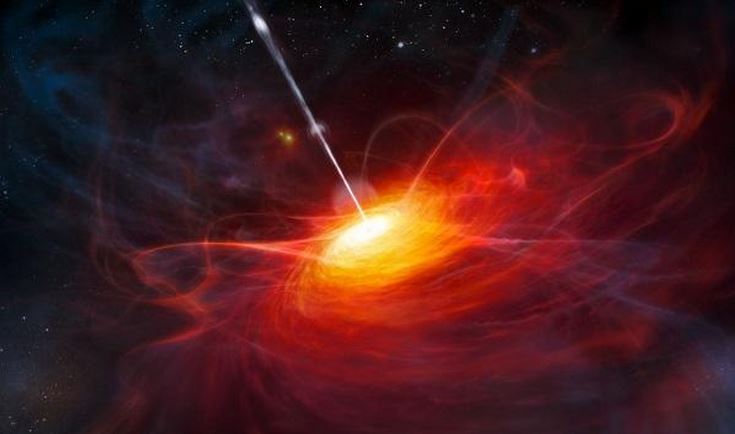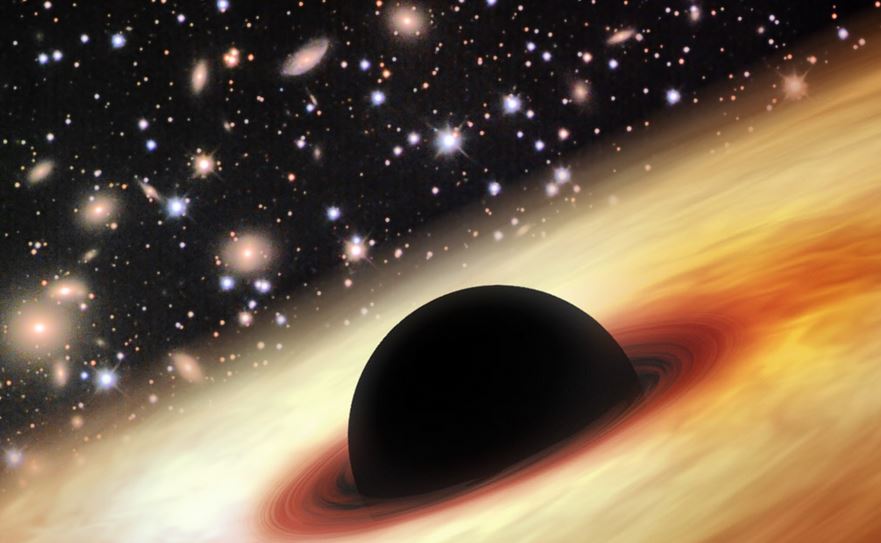An international team of scientists has discovered a supermassive black hole 12.8 billion light years from earth, with 12 billion times the mass of the Sun and 420 trillion times its luminosity. It is so big that it has turned the theory about how black holes grow on its head.
Being 12.8 billion light years away means it existed 900 million years after the Big Bang, which gave birth to our Universe. Scientists cannot explain how it became so big so quickly – so soon after stars and galaxies were formed.
The new celestial object, which has been named SDSS J0100+2802, is at the center of a quasar. Quasars are the furthest objects away from our galaxy that can be seen. They are super-bright masses of light and energy. Quasar stands for quasi-stellar radio source or quasi-stellar object.
Details on the new discovery have been published in the journal Nature (citation below).

An artist’s impression of a very distant, very ancient quasar, courtesy of the European Southern Observatory. (Credit: ESO/M. Kornmesser)
Since they were first discovered in 1963, quasars have remained a mystery. Scientists suggest they are generated by matter heating up as it is pulled into supermassive black holes at the center of faraway galaxies.
Thanks to new technology (new generation of digital sky surveys), more than 200,000 quasars have been discovered, ranging in age from 0.7 billion years after the Big Bang to today.
This quasar was found at a redshift of z=6.30. This is a measurement of how much the wavelength of light emitted from it that reaches us is stretched by the expansion of the Universe.
Scientists use the redshift measurement to calculate its age and distance from us. The higher the redshift the greater the distance and hence looking further back in time.
Since 1963, only 40 quasars that have had a redshift higher than 6 have been identified, a point that marks the beginning of the early Universe.

An artist’s rendering of a quasar with a supermassive black hole in the distant universe. (Image: Zhaoyu Li/NASA/JPL-Caltech/Misti Mountain Observatory)
Team-leader Xue-Bing Wu of Peking University and the Kavli Institute of Astronomy and Astrophysics, said:
“This quasar is very unique. Just like the brightest lighthouse in the distant universe, its glowing light will help us to probe more about the early universe.”
This latest quasar and its supermassive black hole were detected by the 8.2m Gemini North Telescope in Hawaii, the 6.5m Multiple Mirror Telescope (MMT) and 8.4m Large Binocular Telescope (LBT) in Arizona, and the 6.5m Magellan Telescope at Carnegie’s Las Campanas Observatory in Chile.
Co-author, astronomer Yuri Beletsky, of the Carnegie Institution for Science, said:
“This quasar is a unique laboratory to study the way that a quasar’s black hole and host galaxy co-evolve. Our findings indicate that in the early Universe, quasar black holes probably grew faster than their host galaxies, although more research is needed to confirm this idea.”
Co-author, Xiaohui Fan, Regents’ Professor of Astronomy at the University of Arizona’s Steward Observatory, said:
“”How can a quasar so luminous, and a black hole so massive, form so early in the history of the universe, at an era soon after the earliest stars and galaxies have just emerged?” Fan said. “And what is the relationship between this monster black hole and its surrounding environment, including its host galaxy?”
“This ultraluminous quasar with its supermassive black hole provides a unique laboratory to the study of the mass assembly and galaxy formation around the most massive black holes in the early universe.”
Citation: “An ultraluminous quasar with a twelve-billion-solar-mass black hole at redshift 6.30,” Xue-Bing Wu, Feige Wang, Xiaohui Fan, Weimin Yi, Wenwen Zuo, Fuyan Bian, Linhua Jiang, Ian D. McGreer, Ran Wang, Jinyi Yang, Qian Yang, David Thompson & Yuri Beletsky. Nature 26 Feb 2015. DOI: 10.1038/nature14241.

